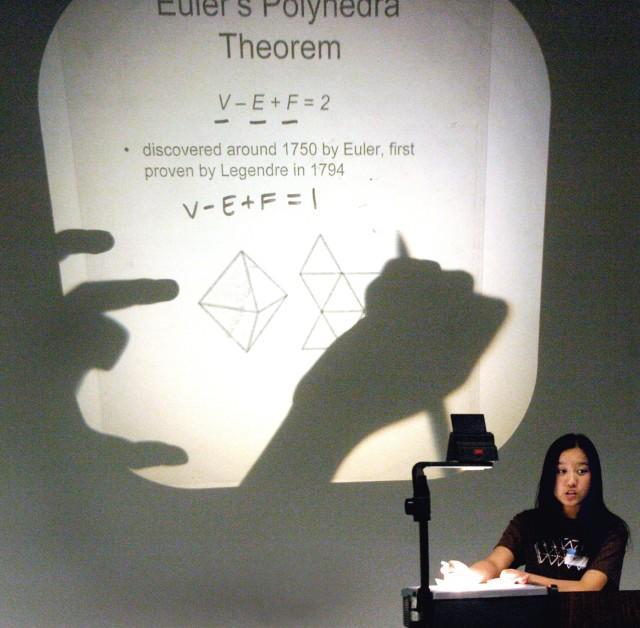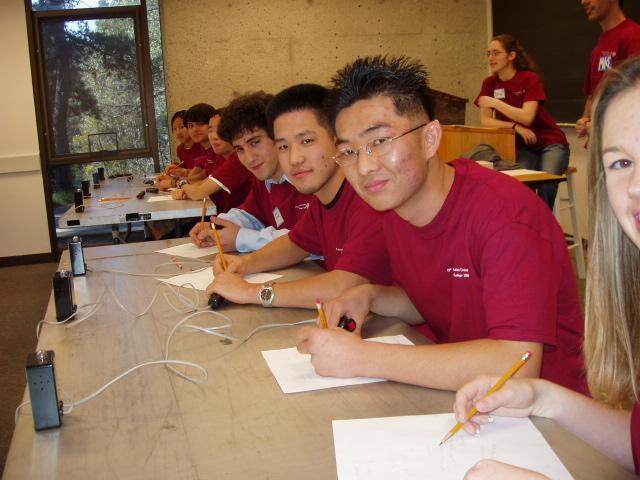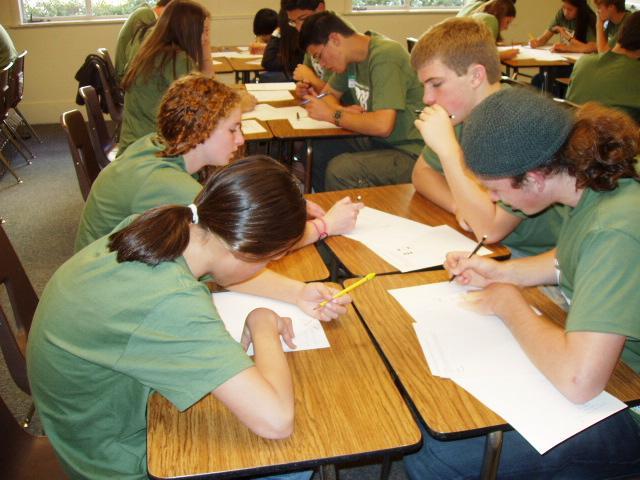Mathematics Field Day Events
Chalk Talk Information
The chalk talk topic for February 7, 2026 is Almost Prime Numbers
Photo courtesy of the Santa Barbara News-Press
Communication is an important part of mathematics, so it is appropriate that our Mathematics Field Day has an event like this one. Each school selects a student to prepare a 10–12 minute talk based on a topic announced well in advance. During preliminary rounds a panel of judges collaborates to determine two finalists, who then redo their presentations before a larger audience and a different set of judges. The topic for 2006 was Polyhedra. Pictured above is the winner for that year, Sue Lin of Dos Pueblos.
Chalk Talk Evaluation Criteria
The evaluation form used by the panel of judges is given below. Generally, the first three categories deal with the style of the talk, while the last three deal with the content.
The talk should last between 10 and 12 minutes. It is up to the student to create a presentation that is well-organized, sufficiently in depth, and focused. In the past, some students have given talks that the students themselves did not completely understand, and the judges counted this against them. In other words, it is important that the person speaking have a good grasp of the subject. A flashy Power Point presentation without good understanding does not make for a winning formula.
The person giving a talk should rehearse it beforehand so that it flows smoothly and is within the 10–12 minute time requirement. Normally the presenter is on the 11th–12th grade team, but this guideline is not mandatory. We hope that this event will be viewed as an opportunity for learning by all the students, regardless of whether they are the presenters. It should also be a lot of fun!
Chalk Talk Evaluation Form
Name:_________________________________________________
School:________________________________________________
CATEGORIES: (Rank Each on a Scale from 1 to 10 with 10 being best)
_____ 1. Clarity of presentation
_____ 2. Use of visual aids
_____ 3. Delivery (including time)
_____ 4. Focus of topic
_____ 5. Depth of topic
_____ 6. Grasp of / correctness of mathematics
_____ TOTAL
College Bowl Information
The “College Bowl” consists of preliminary and final rounds. Teams from various schools compete against one another in several preliminaries, which the above photo illustrates. The two schools with the highest combined scores then advance to the final round to determine the overall winner. Modeled after the College Bowl TV show, students work individually in an attempt to be the first to answer a series of short questions. After each such question the team of the student who answered correctly gets dibs at solving a more difficult follow-up problem. The other team simultaneously works on the same problem, and will be given a chance to answer if the original team provides an incorrect solution.
Team Exam Information
A review of the leading journals reveals that mathematical discovery is a team effort: research articles frequently have more than one author. The purpose of the team exam is to challenge students to think creatively, and to encourage mathematical collaboration. Given a set of five problems, the students must decide how to tackle them. As the above photo shows, the best strategy appears to be some combination of individual and collective effort.
Team Exam Instructions
The following instructions are given to students before they begin their team exam.
Put the name of your school in the space above each answer sheet.
Calculators are not permitted during this exam.
This is a team exam. There are only five questions, so your team will be graded both on the accuracy of your answer and the clarity with which you express your answer. Turn in only one solution per problem per team. Work each problem out on scratch paper at first, then copy the solution you want graded to the space provided below the corresponding question, making sure your writing is legible and coherent. Be sure you justify your answer rather than merely state what the answer is. Use the back of the paper if you run out of room. When time is up, assemble your answers in order and give them to the exam proctor.
Awards Banquet Information
 |  |
 |  |
Westmont’s Mathematics Field Day concludes with an awards banquet. Its purpose is to encourage the students attending to continue their excellent academic work—especially in mathematics. The evening includes dinner, presentation of awards for each event, and a short lecture by a guest speaker. Parents are welcome to attend the banquet at a cost of $25 per person. There is no cost for students and teachers beyond the school registration fee.
Recent Past Speakers:
Manuel Reyes, Mathematics Professor at the University of California Irvine
Alphan Altinok, Lead Engineer at NASA Jet Propulsion Lab
Eric Lucero, Site Lead at Google Quantum AI in Santa Barbara
Russell Howell, Mathematics Professor at Westmont College
Alan Rose, Chief Meteorologist at KEYT News


